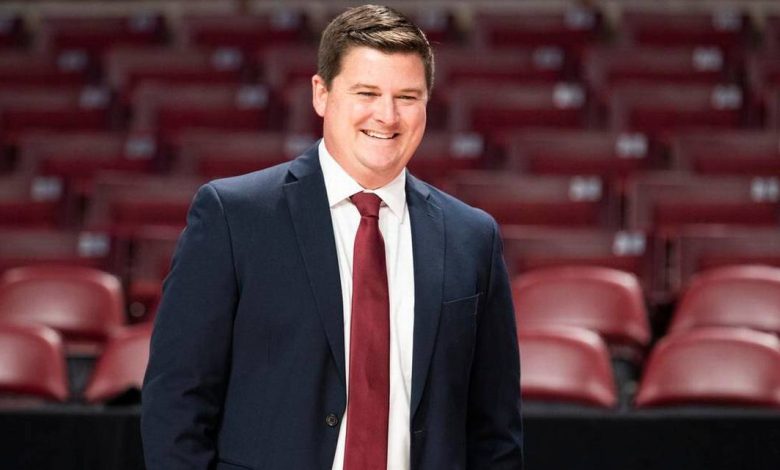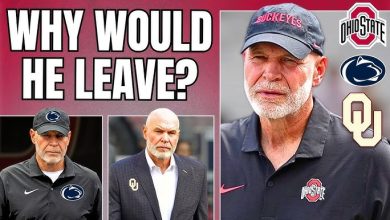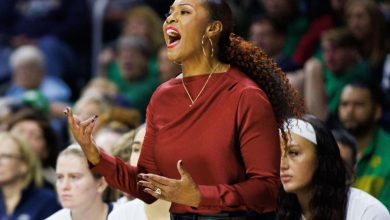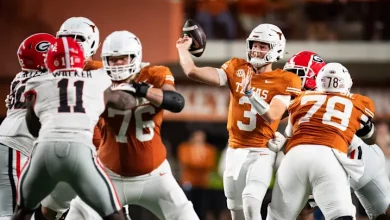The South Carolina Boss Openly Discusses the Challenge of a NIL Future

In recent years, the landscape of college athletics has undergone a massive shift. The introduction of Name, Image, and Likeness (NIL) deals has altered the way college athletes interact with the world of college sports, giving them unprecedented access to revenue opportunities while also posing new challenges for athletic programs, coaches, and universities. For South Carolina, a program that has consistently remained competitive at the highest level, adapting to this new reality has been both a necessary adjustment and an ongoing challenge.
As Dawn Staley, the head coach of the South Carolina Gamecocks women’s basketball team, has helped lead her squad to consistent success, she has been forced to navigate the complexities of NIL while balancing the demands of coaching and recruiting. In recent interviews, Staley, often regarded as one of the most powerful voices in women’s sports, discussed the growing influence of NIL on her program and how she’s adapting to a future where college athletes’ financial opportunities are directly tied to their personal brands.
The shift to NIL, while undeniably beneficial to athletes, has also created significant challenges for programs and coaches. For Staley, understanding how to maintain a cohesive team environment, recruit effectively, and keep a balance between athletics and academics in this new world has been a juggling act. She acknowledges the unique opportunities NIL offers but emphasizes the importance of maintaining the integrity and mission of collegiate athletics.
In this article, we’ll explore the challenges Staley and South Carolina face as they adjust to the future of NIL. We’ll delve into how NIL is affecting the Gamecocks’ recruiting, what this shift means for college athletes moving forward, and how Staley is positioning her program to thrive in a rapidly evolving environment.
1. NIL: A Game-Changer for College Athletics
To fully understand the significance of NIL, it’s important to acknowledge how this new model differs from previous systems in college athletics. Prior to NIL, athletes were prohibited from receiving compensation for their name, image, or likeness, regardless of how prominent they became in their respective sports. This meant that even though athletes were often at the center of massive revenue-generating programs, they were not allowed to directly benefit from their own fame. However, in July 2021, the NCAA officially adopted NIL legislation, allowing college athletes to profit from their name, image, and likeness while still maintaining their eligibility to play.
For athletes, the benefits of NIL are clear. Top college athletes can now engage in endorsement deals, social media promotions, personal brand building, and more. This allows players to capitalize on their visibility and talents while still in college, with some athletes securing significant income. For instance, in the world of women’s basketball, players like Caitlin Clark of Iowa and Aliyah Boston of South Carolina have been able to leverage their success to sign lucrative endorsement deals, offering them the financial benefits that were once reserved for professional athletes.
However, while NIL has been a game-changer for the athletes, it has created new challenges for college coaches and athletic directors, who are forced to balance the business side of sports with the traditional goals of academic achievement and team dynamics.
2. Dawn Staley’s Perspective: The Balancing Act
As one of the most successful coaches in college basketball, Dawn Staley has been a vocal proponent of women’s sports and has long advocated for the empowerment of female athletes. But when it comes to NIL, even Staley has acknowledged that this new era requires careful navigation.
In a recent interview, Staley openly discussed her perspective on the challenges NIL presents for programs like South Carolina. While she sees NIL as a positive development for athletes who have the chance to build their personal brands, she also recognizes the growing pressure it places on athletic programs and coaches. Staley explained that the evolving landscape has made it even more important for coaches to not only recruit talent but also to recruit players who understand the responsibility and discipline that comes with NIL opportunities.
“We’re in a new age,” Staley said. “We need to make sure our players understand that NIL isn’t just about signing deals or making money—it’s about managing their brands and their reputations responsibly. We need them to be students first, athletes second, and brand ambassadors third. It’s a fine line.”
For Staley, the balance between personal development and team success is crucial. She emphasized that while NIL offers immense opportunities for athletes to capitalize on their success, it should not detract from the team-oriented goals that are central to South Carolina’s culture.
3. Recruiting in the NIL Era: The New Dynamic
One of the most immediate impacts of NIL has been the shift in how recruiting is conducted. With the introduction of NIL deals, recruits are now able to look at financial opportunities as a key factor when choosing where to play. Top-tier recruits, especially those with established personal brands, are now making decisions based on factors like the potential for sponsorships, endorsements, and social media reach—an entirely new layer to the recruiting process.
For a program like South Carolina, which has long been a national contender in women’s basketball, NIL presents both a challenge and an opportunity. On one hand, the program has the resources, media presence, and fanbase to offer lucrative NIL deals to its athletes. On the other hand, the program must navigate the complexities of recruiting players who are not only a good fit for the team but also capable of managing the financial and personal pressure that comes with NIL deals.
Staley pointed out that recruiting in the NIL era is no longer just about selling the program’s values, coaching philosophy, or the ability to win championships. Instead, recruits are now asking questions about how the program supports NIL efforts, what the potential opportunities are, and how the school helps athletes navigate this complex new reality.
“We have to educate both recruits and their families about the NIL process,” Staley said. “It’s not just about who’s going to offer the most money. It’s about providing a program that supports our players as they learn how to balance NIL with their academics, athletics, and personal lives.”
Staley believes that South Carolina is uniquely positioned to thrive in this new recruiting environment. The Gamecocks have an established reputation as a powerhouse, which naturally draws attention to their athletes. Additionally, Columbia, South Carolina’s capital city, offers a robust community of local businesses and organizations eager to partner with athletes. However, Staley also pointed out that the Gamecocks must be careful not to prioritize NIL deals over the core principles of team success.
4. Building a Sustainable NIL Program
One of the key challenges in the NIL era is creating a sustainable NIL program that benefits athletes in the long term while maintaining the integrity of the team and the sport. South Carolina has taken several steps to ensure that their athletes are prepared for this new financial landscape, both in terms of understanding the business aspects of NIL and managing their personal brands responsibly.
Staley and her staff have placed a strong emphasis on education, providing resources and support for athletes to navigate their NIL opportunities. This includes partnering with local businesses and marketing agencies to connect athletes with appropriate sponsorship opportunities. It also involves educating athletes about financial literacy, contract negotiations, and the potential pitfalls of NIL deals, such as managing taxes and public relations.
South Carolina also understands the importance of fostering a team-first mentality, which Staley has instilled throughout her tenure as head coach. She pointed out that NIL deals should not overshadow the collective goals of the team, and athletes must still work together to achieve success on the court. Staley emphasized that success in NIL deals should come as a natural extension of an athlete’s hard work and dedication to their sport, not as a distraction.
“We don’t want NIL to be the reason they come to South Carolina,” Staley explained. “We want them to come here because they believe in the mission, the team, and the culture. NIL should be a tool that enhances their college experience, not something that detracts from it.”
5. The Impact on Women’s Sports: A Level Playing Field?
For women’s sports, NIL presents both tremendous opportunity and considerable challenges. Historically, female athletes have not had the same access to endorsement opportunities as their male counterparts, and many women’s sports programs have struggled to generate the same level of financial resources and media attention as men’s programs. However, NIL is poised to change that dynamic.
Staley has expressed optimism about how NIL can level the playing field for female athletes. “For the first time, women’s athletes have the chance to control their own brands,” she said. “We’ve seen how players like Aliyah Boston have been able to benefit from their hard work and performance on the court. NIL allows them to not only get paid but also become true influencers in their respective communities.”
Through NIL, athletes in women’s sports now have the chance to partner with brands and organizations that align with their personal values and interests. Whether it’s working with companies focused on sustainability, advocating for women’s rights, or promoting products that are important to them, female athletes are now able to amplify their voices and build platforms that extend beyond the playing field.
6. Looking Ahead: Embracing the Future of NIL
As South Carolina navigates the new world of NIL, Staley remains confident that the program will adapt and thrive in this evolving landscape. While challenges remain, she believes that NIL has the potential to empower athletes, improve financial equity in women’s sports, and help players build long-term careers both on and off the court.
“I believe in the power of education,” Staley said. “If we can teach our athletes how to manage their brands responsibly, and if we can help them focus on the bigger picture—academics, athletics, and personal growth—we’ll be fine. NIL is just another tool in helping our athletes become successful both on and off the court.”
The Gamecocks, with their history of success and commitment to developing well-rounded athletes, are positioning themselves to lead in the new NIL era. Whether it’s through attracting top recruits, empowering female athletes, or building sustainable NIL programs, South Carolina is ready to face the future head-on, and Dawn Staley’s leadership will undoubtedly continue to shape the path forward.









